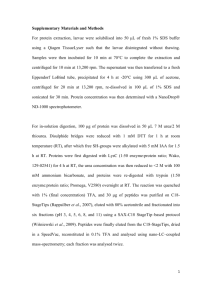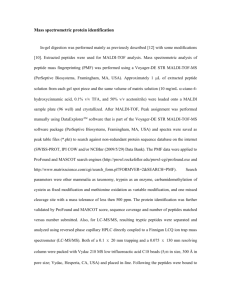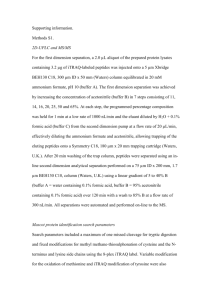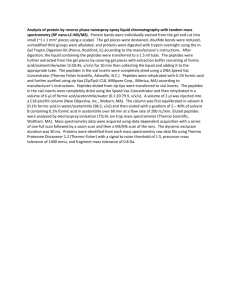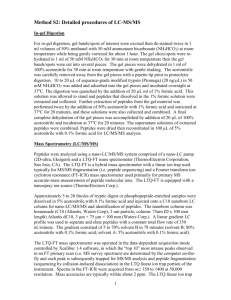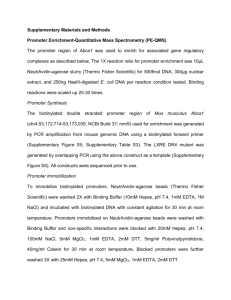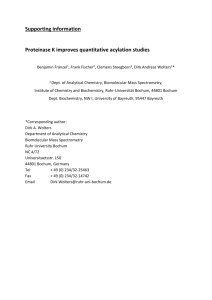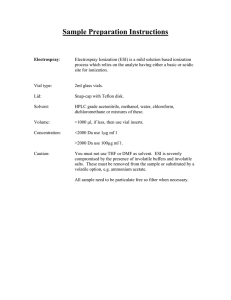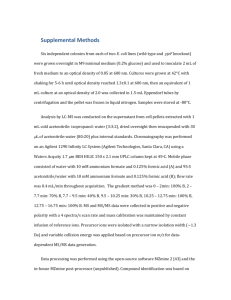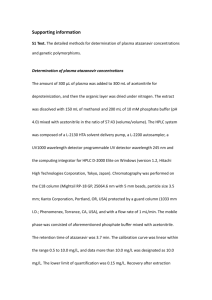tpj12691-sup-0010-DataS4
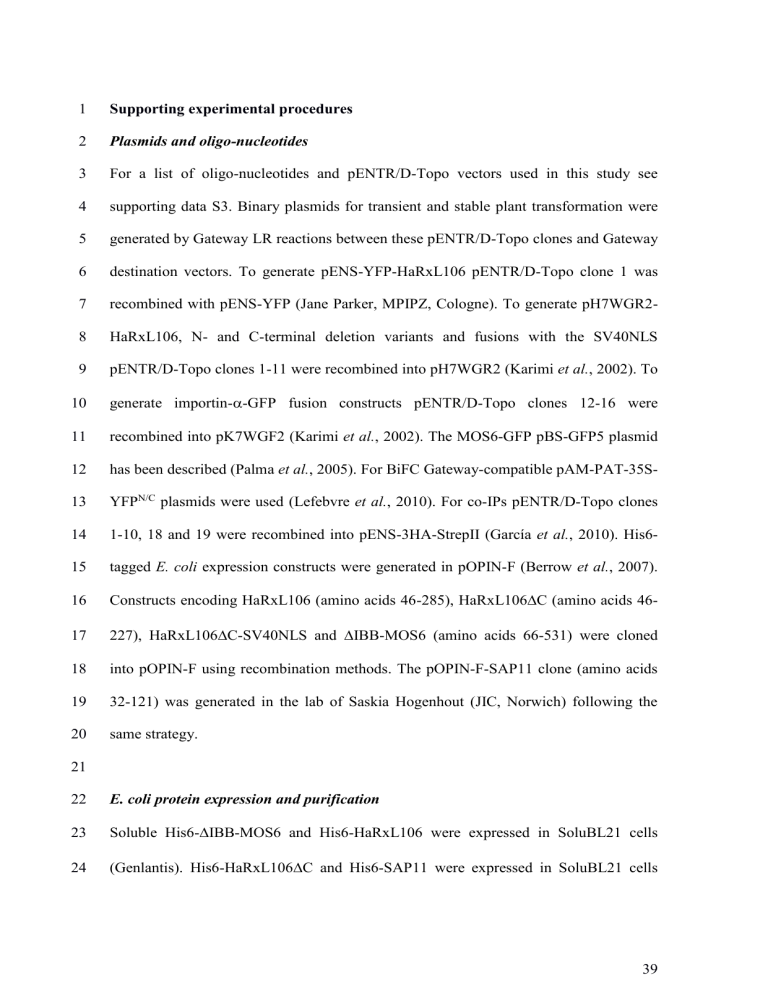
1 Supporting experimental procedures
2 Plasmids and oligo-nucleotides
3 For a list of oligo-nucleotides and pENTR/D-Topo vectors used in this study see
4 supporting data S3. Binary plasmids for transient and stable plant transformation were
5 generated by Gateway LR reactions between these pENTR/D-Topo clones and Gateway
6 destination vectors. To generate pENS-YFP-HaRxL106 pENTR/D-Topo clone 1 was
7 recombined with pENS-YFP (Jane Parker, MPIPZ, Cologne). To generate pH7WGR2-
8 HaRxL106, N- and C-terminal deletion variants and fusions with the SV40NLS
9
10 pENTR/D-Topo clones 1-11 were recombined into pH7WGR2 (Karimi et al.
, 2002). To generate importin-
-GFP fusion constructs pENTR/D-Topo clones 12-16 were
11 recombined into pK7WGF2 (Karimi et al.
, 2002). The MOS6-GFP pBS-GFP5 plasmid
12 has been described (Palma et al.
, 2005). For BiFC Gateway-compatible pAM-PAT-35S-
13 YFP
N/C
plasmids were used (Lefebvre et al.
, 2010). For co-IPs pENTR/D-Topo clones
14 1-10, 18 and 19 were recombined into pENS-3HA-StrepII (García et al.
, 2010). His6-
15
16 tagged E. coli expression constructs were generated in pOPIN-F (Berrow et al.
, 2007).
Constructs encoding HaRxL106 (amino acids 46-285), HaRxL106
C (amino acids 46-
17 227), HaRxL106
C-SV40NLS and
IBB-MOS6 (amino acids 66-531) were cloned
18 into pOPIN-F using recombination methods. The pOPIN-F-SAP11 clone (amino acids
19 32-121) was generated in the lab of Saskia Hogenhout (JIC, Norwich) following the
20 same strategy.
21
22
23
E. coli protein expression and purification
Soluble His6-
IBB-MOS6 and His6-HaRxL106 were expressed in SoluBL21 cells
24 (Genlantis). His6-HaRxL106
C and His6-SAP11 were expressed in SoluBL21 cells
39
1 transformed with the Rosetta pRARE plasmid. Bacterial cultures were grown to OD
600
2 0.8-1.0 in LB broth at 37 ºC, then cooled to 18 ºC and protein expression was induced
3 by 1mM IPTG followed by overnight incubation at 18 ºC. For His6-HaRxl106, DMSO
4 was added to a final concentration of 0.4% in the growth medium to promote expression
5 of soluble protein. The cells were harvested by centrifugation at 5000 x g and cell
6 pellets were frozen at -80 ºC. The pellets were resuspended in 50 mM HEPES, 300 mM
7 NaCl, 25 mM imidazole, pH 7.8 and bacteria were lyzed by addition of lysozyme
8 followed by sonication. Debris and insoluble proteins were cleared by centrifugation
9 (30,000 x g
, 4 ºC, 20 min) and the supernatant was loaded onto pre-equilibrated Ni
2+
-
10 immobilized metal ion affinity chromatography columns. Following column washing,
11
12 bound proteins were eluted in 50 mM HEPES, 300 mM NaCl, 250 mM imidazole, pH
7.8 and directly injected on Hi-Load 26/60 Superdex 75 (HaRxL106, HaRxL106
C,
13 SAP11) or Superdex 200 (
IBB-MOS6) size exclusion columns (GE Healthcare) using
14 20 mM HEPES, 150 mM NaCl, pH 7.5 as the running buffer. Proteins were
15 concentrated using ultrafiltration columns (Sartorius) and snap-frozen in liquid nitrogen.
16
17 Crystallization of
IBB-MOS6 and structure determination
18 For crystallization of
IBB-MOS6, the N-terminal His6-tag was cleaved by 3C protease
19 and the protein was re-purified by size exclusion chromatography.
IBB-MOS6 was
20 concentrated to 12.5 mg/ml and used for crystallization screening.
IBB-MOS6 crystals
21 formed in 0.2 M Mg-acetate, 0.1 M Na-cacodylate pH 6.5, 20% PEG8000.
22 Crystallization conditions were further optimized to 0.2 M Mg-acetate, 0.1 M MES pH
23 6.5, 19% PEG3350 in hanging drop plates. Crystals were harvested in Paratone-N and
24 snap-frozen in liquid nitrogen. A diffraction data set from a single crystal was collected
40
1 on beamline i02 at Diamond Light Source (Oxford, UK). X-ray data were processed
2 with iMosflm (Leslie, 2006) and scaled with Aimless (Evans and Murshudov, 2013)
3
4 from the CCP4 suite (Collaborative Computational Project, Number 4, 1994). For X-ray data collection statistics see Table S1. The
IBB-MOS6 structure was solved my
5 molecular replacement using Phaser (McCoy et al.
, 2007) and rice importin-
1a (PDB
6 4B8J) as a search model. Iterative building and refinement cycles using Coot (Emsley et
7 al.
, 2010), Refmac5 (Murshudov et al.
, 2011) and Phenix (Adams et al.
, 2010) were
8 used to obtain the final model with statistics given in Table S2. Validation tools in
9 Molprobity (Chen et al.
, 2010) and Coot were used to analyse the final structure. 3D
10 visualizations of protein structures were prepared using PyMOL software v1.7.2
11 (http://sourceforge.net/projects/pymol/).
12
13 Mass spectrometry
14 Samples for LC MS analysis were prepared by excising bands from one-dimensional
15 SDS-PAGE gels stained with colloid Coomassie Brilliant Blue. The gel slices were
16 destained with 50% acetonitrile, and cysteine residues modified by 30 min reduction in
17 10 mM DTT followed by 20 min alkylation with 55 mM chloroacetamide. After
18 extensive washing with destaining solvent and 100% acetonitrile, gel pieces were
19 incubated with trypsin (Promega) in 100 mM ammonium bicarbonate and 5%
20 acetonitrile in water at 37 ºC overnight.
21 LCMS/MS analysis was performed using a hybrid mass spectrometer LTQ-Orbitrap XL
22 (ThermoFisher Scientific) and a nanoflow-UHPLC system (nanoAcquity, Waters Corp.)
23 The generated peptides were applied to a reverse phase trap column (Symmetry C18, 5
24
41
1 -T
2 coupling union. Peptides were eluted in a gradient of 3-40 % acetonitrile in 0.1 %
3 formic (solvent B) acid over 50 min followed by gradient of 40-60 % B over 3 min at a
4 flow rate of 250 nL min
-1
at 40°C. The mass spectrometer was operated in positive ion
5 mode with nano-electrospray ion source with ID 0.02mm fussed silica emitter (New
6 Objective). Voltage +2kV was applied via platinum wire held in PEEK T-shaped
7 coupling union. Transfer capillary temperature was set to 200 ºC, no sheath gas, and the
8 focusing voltages in factory default setting were used. The Orbitrap, MS scan resolution
9 of 60,000 at 400 m/z, range 300 to 2000 m/z was used, and automatic gain control
10 (AGC) target was set to 1000000 counts, and maximum inject time to 1000ms. In the
11 linear ion trap (LTQ), MS/MS spectra were triggered with data dependent acquisition
12 method for the 5 most intense ions. The threshold for collision-induced dissociation
13 (CID) was above 1000 counts, using normal scan rate types, AGC accumulation target
14 was set to 30,000 counts, and maximum inject time to 150ms. A data dependent
15 algorithm was used to collect as many tandem spectra as possible from all masses
16 detected in master scan in the Orbitrap. For the latter, Orbitrap pre-scan functionality,
17 isolation width 2 m/z and collision energy set to 35 % were used. The selected ions were
18 then fragmented in the ion trap using CID. Dynamic exclusion was enabled allowing for
19 1 repeat only, with a 60 sec exclusion time, and maximal size of dynamic exclusion list
20 500 items. Chromatography function to trigger MS/MS event close to the peak summit
21 was used with correlation set to 0.9, and expected peak width 7s. Charge state screening
22 enabled allowed only higher than 2+ charge states to be selected for MS/MS
23 fragmentation.
24
42
1 Software processing and peptide identification
2 Peak lists in format of Mascot generic files were prepared from raw data using
3 Proteome Discoverer v1.2 (ThermoFisher Scientific) and concatenated using in house
4 developed Perl script. Peak picking settings were as follows: m/z range set to 300-5000,
5 minimum number of peaks in a spectrum was set to 1, S/N threshold for Orbitrap
6 spectra set to 1.5, and automatic treatment of unrecognized charge states was used. Peak
7 lists were searched on Mascot server v.2.4.1 (Matrix Science) against TAIR (version 10)
8 database. Tryptic peptides only, up to 2 possible miscleavages and charge states +2, +3,
9 +4, were allowed in the search. The following modifications were included in the search:
10 oxidized methionine (variable), carbamidomethylated cysteine (static). Data were
11 searched with a monoisotopic precursor and fragment ions mass tolerance 10ppm and
12 0.8Da respectively. Mascot results were combined in Scaffold v. 4 (Proteome Software,
13 (Searle, 2010)) and exported in Excel (Microsoft Office) .
Peptide identifications were
14 accepted if they could be established at greater than 95.0% probability by the Peptide
15 Prophet algorithm (Keller et al.
, 2002) with Scaffold delta-mass correction. Protein
16 identifications were accepted if they could be established at greater than 99.0%
17 probability and contained at least 2 identified peptides. Protein probabilities were
18 assigned by the Protein Prophet algorithm (Nesvizhskii et al.
, 2003) . Proteins that
19 contained similar peptides and could not be differentiated based on MS/MS analysis
20 alone were grouped to satisfy the principles of parsimony.
43
